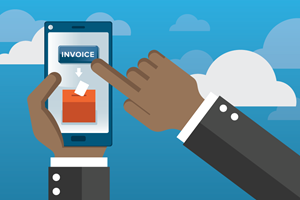Say goodbye to paper invoices and embrace AP automation
We are living in a time of rapid change and technological advance. This is the time of the internet. A time when people can do virtually anything online: order food, request a ride, buy groceries, open the garage door, schedule home lighting, buy a song, play a game, read a book, pay the bills, get driving directions, file taxes, read the news, watch a TV series, and more.
In these times, when almost everything can be done electronically and online, it’s hard to believe many companies—big and small—still receive their invoices on paper and process them manually.
If you are shocked by this assertion, you must be doing it right. But you are in the minority. According to 2016 research from the American Productivity & Quality Center, companies manually enter 58% of invoices into their financial system.
This means the billing information they received was on paper, not sent electronically. And then, someone had to physically collect the invoice, enter it into the accounts payable (AP) system, match it to a purchase order for verification purposes, and obtain approval to pay.
The cost of manual processing
Manual invoice processing increases the chance of data entry errors, which can take several days to be resolved. This can cause delays in getting invoices processed, and can also cost you the loss of an early-payment discount.
"According to a 2014 report by the Aberdeen Group, the average cost of manually processing an invoice is $16.33."
So what is the cost of manual processing? According to a 2014 report by the Aberdeen Group, the average cost of manually processing an invoice is $16.33. And that doesn’t include the non-quantifiable cost of having the AP team dedicated to manual and repetitive tasks when they could be providing valuable insights to their functional partners in purchasing and treasury.
Save time and money with AP automation
If your company is still entering invoices manually, it’s time to take advantage of today’s technology -- and begin automating AP. A best-in-class AP automation should include the following features:
- Accepting electronic submission of invoices from suppliers in various forms. That is accepting PDFs sent via email, electronic files manually uploaded to a website or automatically transferred server-to-server, or invoices manually keyed in by the supplier via an online portal.
- Automating the three-way-match process. With this automation each invoice is automatically matched to the corresponding PO and to the receipt—if any.
- Approval workflows. With workflows, invoices that don’t have a corresponding PO can be verified and approved. A big advantage of workflows is that they provide excellent audit trails.
Options for AP automation
AP automation can be accomplished in a number of ways: by the internal IT team, by upgrading to an ERP solution that receives electronic invoices and performs automated matching, or by buying an AP automation solution that “talks” with the existing ERP.
You can automate the full procure-to-pay (P2P) cycle, or do it in pieces: receive electronic invoices, automate the matching to the purchase order, do electronic payments, launch a supplier portal, etc.
AvidXchange is an AP automation solution that acts as a bridge to take a financial and accounting system away from paper invoices. They offer a complete suite that includes:
- An electronic-ready purchasing module
- A bill service that accept invoices for you and converts them into electronic files
- An invoice application module that takes the electronic files and adds them to your AP
- A payment module that executes payments in electronic format
- A pay service that works with your providers to bring them to the electronic era for you
When choosing the best path to automate AP for your company, work with a true business partner like RKL, a company with the knowledge and experience to offer you the best solution so you can say goodbye to paper invoices.



